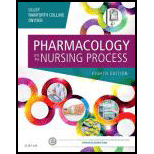
To provide:
The specific examples of drugs that are categorized as expectorants, decongestants, antitussives, and antihistamines (both nonsedating and sedating).
Concept introduction:
The common cold is referred to as an acute disease that occurs in the upper respiratory tract. It occurs due to the infection of viruses such as influenza virus or rhinovirus. The mucosa of the upper respiratory tracts such as the nose, larynx, and pharynx was invaded by the virus to cause the URI (upper respiratory tract infection). The inflammation in the mucosa stimulates the excessive production of the mucus and it gets accumulated in the regions of the upper respiratory tract. This leads to the symptoms of a cold such as nasal congestion, sore throat, sneezing, and coughing. These common cold symptoms are treated with the combined use of the expectorants, antihistamines, antitussives, and nasal decongestants.
Explanation of Solution
Antihistamines are a group of substances that are used to reduce the allergic reactions that occur due to pharmacologic and physiologic effects of the histamine. Decongestants are used to reduce the swelling or congestion of the respiratory tract. Excessive nasal secretions were controlled by the decongestants. Expectorants refer to the drugs that are used to increase the flow of mucus or phlegm in the respiratory tract. These drugs reduce the thickness of the secretions and it is cleared out by coughing. Antitussive drugs are used to reduce or suppress coughing.
Some of the particular examples of the drugs that are classified as antitussives, antihistamines, expectorants, and nasal decongestants are as follows:
Antihistamines:
- Loratidine (Claritin) (B) – nonsedating antihistamine.
- Diphenhydramine (Benadryl) (B) – sedating antihistamine.
Antitussives:
- Benzonatate (Tessalon Perles).
- Codeine.
- Dextromethorphan.
Expectorants:
- Guaifenesin.
Decongestants:
- Naphazoline (Privine).
Certain specific examples of drugs that are used in treating the upper respiratory infections on the basis of their category are provided.
Want to see more full solutions like this?
Chapter 36 Solutions
Pharmacology and the Nursing Process, 8e
- true or false dark skinned infants should be screened for vitamin D levelsarrow_forwardtrue or false any practice employee is authorized to and should communicate collection guidelines with practice?arrow_forwardrtrue or false equesting a listing of specific creditreferences during patient intake os an acceptable business practice?arrow_forward
- give an overview on the respiratory assessmentarrow_forwardexplain an abdominal exam?arrow_forwardDiscuss β -Lactam antibiotics under the following subheadings Classifications of penicillins Classification of Cephalosporins General Mechanism of Actions Clinical Indications of penicillins and cephalosporins Adverse effects of β-lactamsarrow_forward
- a. Define neoplasm b. Differentiate between benign and malignant tumours c. Describe the molecular basis of cancerarrow_forwarddifferentiate the extra heart sounds S3,S4, murmurs and gallopsarrow_forward• Define shock and list types of shock • Discuss pathogenesis of septic shock. • Enumerate the stages of shock. • Define oedema and describe the pathophysiologic mechanisms of oedema with examples.arrow_forward
- Discuss Hypertension under the following headings: Definition Diagnosis Non-pharmacological intervention Drugs Classification Management of a Hypertensive emergencyarrow_forwardExplain how the answer could be 2 or 1.8 WITHOUT changing the questionarrow_forwardoverview of the neurological system, cranial nerves and what part of the body it innervatesarrow_forward
 Phlebotomy EssentialsNursingISBN:9781451194524Author:Ruth McCall, Cathee M. Tankersley MT(ASCP)Publisher:JONES+BARTLETT PUBLISHERS, INC.
Phlebotomy EssentialsNursingISBN:9781451194524Author:Ruth McCall, Cathee M. Tankersley MT(ASCP)Publisher:JONES+BARTLETT PUBLISHERS, INC. Gould's Pathophysiology for the Health Profession...NursingISBN:9780323414425Author:Robert J Hubert BSPublisher:Saunders
Gould's Pathophysiology for the Health Profession...NursingISBN:9780323414425Author:Robert J Hubert BSPublisher:Saunders Fundamentals Of NursingNursingISBN:9781496362179Author:Taylor, Carol (carol R.), LYNN, Pamela (pamela Barbara), Bartlett, Jennifer L.Publisher:Wolters Kluwer,
Fundamentals Of NursingNursingISBN:9781496362179Author:Taylor, Carol (carol R.), LYNN, Pamela (pamela Barbara), Bartlett, Jennifer L.Publisher:Wolters Kluwer, Fundamentals of Nursing, 9eNursingISBN:9780323327404Author:Patricia A. Potter RN MSN PhD FAAN, Anne Griffin Perry RN EdD FAAN, Patricia Stockert RN BSN MS PhD, Amy Hall RN BSN MS PhD CNEPublisher:Elsevier Science
Fundamentals of Nursing, 9eNursingISBN:9780323327404Author:Patricia A. Potter RN MSN PhD FAAN, Anne Griffin Perry RN EdD FAAN, Patricia Stockert RN BSN MS PhD, Amy Hall RN BSN MS PhD CNEPublisher:Elsevier Science Study Guide for Gould's Pathophysiology for the H...NursingISBN:9780323414142Author:Hubert BS, Robert J; VanMeter PhD, Karin C.Publisher:Saunders
Study Guide for Gould's Pathophysiology for the H...NursingISBN:9780323414142Author:Hubert BS, Robert J; VanMeter PhD, Karin C.Publisher:Saunders Issues and Ethics in the Helping Professions (Min...NursingISBN:9781337406291Author:Gerald Corey, Marianne Schneider Corey, Cindy CoreyPublisher:Cengage Learning
Issues and Ethics in the Helping Professions (Min...NursingISBN:9781337406291Author:Gerald Corey, Marianne Schneider Corey, Cindy CoreyPublisher:Cengage Learning





